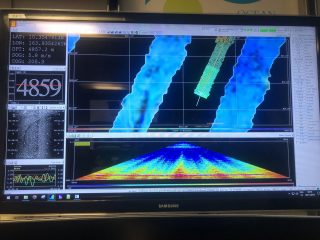My passion and love for marine biology and oceanography started with simple stories of adventure. Robin J. Cadiz, (or Mr. Cadiz as I referred to him in high school) sparked my interest in marine science during my freshman year of high school. As a former marine scientist himself, Mr. Cadiz told the class his stories about conducting research out in the seas off Antarctica, giving us a taste of what it was actually like to do research while battling nature’s harsh, relentless elements. In addition to all the amazing facts about whales and penguins, Mr. Cadiz always had something to grab the class’s attention. His stories were always exciting and awe-inspiring, so much so that they are what have carried me to where I am today.
As a student fascinated with marine science, I have found my time on R/V Falkor to be amazing. If you too are an aspiring scientist of any kind (your focus does not have to be marine science), I highly suggest looking into Schmidt Ocean Institute’s student opportunities program. This program has given me a valuable and unique experience that I will remember for the rest of my life.

Falkor has many different research opportunities to get involved with while on board. Just to name a few that are on my transit: oceanographic mapping, measuring nitrogen fixation rates, and studying carbon chemistry within the microlayers on the surface ocean. For me personally, I wanted to discover the science behind oceanographic mapping.

The Falkor helps in the Nippon Foundation-GEBCO Seabed 2030 Project with the hopes of mapping the entire ocean floor under high resolution by the year 2030. On my transit, I got to see how the Falkor uses multi-beam technology to accurately draw the ocean floor. As the Falkor moves along past the ocean floor, low-frequency sound waves, or pings, are sounded off. These sound waves hit the bottom of the ocean and are reflected and received back to on the ship where it can then determine the depth and composition of the ocean floor whether it be sand, rock, etc. However, this multibeam technology is not as simple as sending waves of sound out, it must also take into account many other factors. For example, it also takes into account the angle of the ship before it sends out the ping, as well as the angle after receiving the ping – these change quickly on a rocking ship on rough seas – as these differences in angle impact the distance recorded. In addition, the technology must calculate the varying differences in the speed of sound since it can change with variances in temperature and salinity. Low-frequency waves are at times preferred over higher frequency waves as they can travel farther – while on the Falkor I have noticed that they sometimes reach depths of up to 6000 meters!
After one week aboard the Falkor, I am still learning and discovering new things and I cannot wait to go back home and tell everyone about my experience thus far. Within the next week, I am planning to learn more about the other people on board, including our Artist-at-Sea and the ship’s captain. I hope to learn more about how the ship operates and navigate across the giant Pacific Ocean. More to come!

